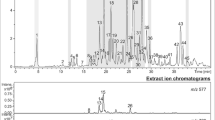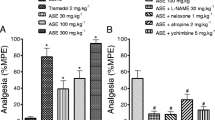We examined the effects of an aqueous extract from seeds of Securigera securidaca L. (S. s.), a plant used in folk medicine, on experimentally induced pain in balb-c mice. The tail-flick test (somatic pain evoked by thermonociceptive stimulation) and writhing test (visceral pain after i.p. injections of acetic acid) were used. Three doses of the extract (85, 170, 340 mg of dry substance per 1 kg body mass) were i.p. injected before the tests. Significant antinociception effects were observed in both tests; a dose of 170 mg/kg appeared to be optimum. Antinociceptive effects of the S. s. extract were comparable with those of 1 mg/kg morphine. Naloxone, metoclopramide, ondancetron, and scopolamine (antagonists of opioid, dopamine, serotonin, and cholinergic receptors, respectively) completely eliminated antinociceptive effects of the S. s. extract in the tail-flick test; the effects of these antagonists were not so clear in the writhing test. The mechanisms of analgesic actions of the S. s. extract are discussed; the respective effects are probably related (at least partly) to the presence of flavonoids in this extract. Further investigations are necessary for adequate interpretation of the above mechanisms.
Similar content being viewed by others
References
J. B. Calixto, A. Beirith, J. Ferreira, et al., “Naturally occurring antinociceptive substances from plants,” Phytother. Res., 14, No. 6, 401–418 (2000).
A. Ghahraman, Flore de Iranen Coulerus Naturelle, Vol. 12, Tehran Univ. Press, Tehran (1993)
M. Ghazi and B. Maki, “Effect of Securigera securidaca on electroshock seizure threshold in mice,” Psychol. Rep., 24, No. 2, 551–553 (1969).
A. Ali, M. Mohamed, M. Kamel, et al., “Studies on Securigera securidacea L., Deg. et Dörfl. (Fabaceae) seeds, an antidiabetic Egyptian folk medicine,” Pharmazie, 53, No. 10, 710–715 (1998).
H. Hosseinzadeh, M. Ramezani, and A. Danaei, “Antihyperglycaemic effect and acute toxicity of Securigera securidaca L. seed extracts in mice,” Phytother. Res., 16, No. 8, 745–747 (2002).
A. Garjani, F. Fathiazad, A. Zakheri, et al., “The effect of total extract of Securigera securidaca L. seeds on serum lipid profiles, antioxidant status, and vascular function in hypercholesterolemic rats,” J. Ethnopharmacol., 126, No. 3, 525–532 (2009).
M. Pouramir, M. E. Shahaboddin, A. A. Moghadamnia, and K. Parastouei, “To study the effects of Securigera securidaca (L.) seed against alloxan-induced hyperglycemia,” J. Med. Plants Res., 14, No. 5, 3188–3191 (2011).
E. M. Choi, “Antinociceptive and antiinflammatory activities of pine (Pinus densiflora) pollen extract,” Phytother. Res., 21, No. 5, 471–475 (2007).
G. Kekesi, I. Dobos, G. Benedek, and G. Horvath, “Antinociceptive activity of Sempervivum tectorum L. extract in rats,” Phytother. Res., 17, No. 9, 1032–1036 (2003).
S. R. Mada, M. R. Metukuri, L. Burugula, et al., “Antiinflammatory and antinociceptive activities of gossypin and procumbentin–cyclooxygenase-2 (COX-2) inhibition studies,” Phytother. Res., 23, No. 6, 878–884 (2009).
G. Gutiérrez-Venegas, M. Jiménez-Estrada, and S. Maldonado, “The effect of flavonoids on transduction mechanisms in lipopolysaccharide-treated human gingival fibroblasts,” Int. J. Immunopharmacol., 7, No. 9, 1199–1210 (2007).
A. Dehpour, H. Sadeghipour, A. Nowroozi, and N. Akbarloo, “The effect of the serotonergic system on opioid withdrawal-like syndrome in a mouse model of cholestasis,” Human Psychopharmacol. Clin. Exp., 15, No. 6, 423–428 (2000).
R. Depoortere, M. Meleine, L. Bardin, et al., “Milnacipran is active in models of irritable bowel syndrome and abdominal visceral pain in rodents,” Eur. J. Pharmacol., 672, Nos. 1/3, 83–87 (2011). doi:10.1016/j.ejphar.2011.09.182
K. Vidyalakshmi, P. Kamalakannan, S. Viswanathan, and S. Ramaswamy, “Antinociceptive effect of certain dihydroxyflavones in mice,” Pharmacol. Biochem. Behav., 96, No. 1, 1–6 (2010).
P. Thirugnanasambantham, S. Viswanathan, C. Mythirayee, et al., “Analgesic activity of certain flavone derivatives: a structure-activity study,” J. Ethnopharmacol., 28, No. 2, 207–214 (1990).
P. Thirugnanasambantham, S. Viswanathan, S. Ramaswamy, et al., “Analgesic activity of certain flavone derivatives: A structure-activity study,” Clin. Exp. Pharmacol. Physiol., 20, No. 1, 59–63 (1993).
S. Umamaheswari, S. Viswanathan, B. Sathiyasekaran, et al., “Antinociceptive activity of certain dihydroxy flavones,” Ind. J. Pharm. Sci., 68, No. 6, 749–753 (2006).
A. W. Filho, V. C. Filho, L. Olinger, and M. M. de Souza, “Quercetin: further investigation of its antinociceptive properties and mechanisms of action,” Arch. Pharmacol. Res., 31, No. 6, 713–721 (2008).
P. S. Naidu, A. Singh, and S. K. Kulkarni, “D2-dopamine receptor and α2-adrenoreceptormediated analgesic response of quercetin,” Ind. J. Exp. Biol., 41, No. 12, 1400–1404 (2003).
R. Kaur, D. Singh, and K. Chopra, “Participation of α2 receptors in the antinociceptive activity of quercetin,” J. Med. Food, 8, No. 4, 529–532 (2005).
L. R. Lapa, V. M. Gadotti, F. C. Missau, et al., “Antinociceptive properties of the hydroalcoholic extract and the flavonoid rutin, obtained from Polygala paniculata L., in mice,” Basic Clin. Pharmacol. Toxicol., 104, No. 4, 306–315 (2009).
P. L. Katavic, K. Lamb, H. Navarro, and T. E. Prisinzano, “Flavonoids as opioid receptor ligands: identification and preliminary structure-activity relationships,” J. Nat. Prod., 70, No. 8, 1278–1282 (2007).
A. L. Martinez, M. E. González-Trujano, M. Chávez, et al., “Hesperidin produces antino ciceptive response and synergistic interaction with ketorolac in an arthritic gout-type pain in rats,” Pharmacol. Biochem. Behav., 97, No. 4, 683–689 (2010).
L. M. Loscalzo, C. Wasowski, A. C. Paladini, and M. Marder, “Opioid receptors are involved in the sedative and antinociceptive effects of hesperidin as well as in its potentiation with benzodiazepines,” Eur. J. Pharmacol., 580, No. 3, 306–313 (2008).
Author information
Authors and Affiliations
Corresponding author
Rights and permissions
About this article
Cite this article
Shahidi, S., Pahlevani, P. Antinociceptive Effects of an Extract of Securigera securidaca and Their Mechanisms in Mice. Neurophysiology 45, 34–38 (2013). https://doi.org/10.1007/s11062-013-9334-0
Received:
Published:
Issue Date:
DOI: https://doi.org/10.1007/s11062-013-9334-0




